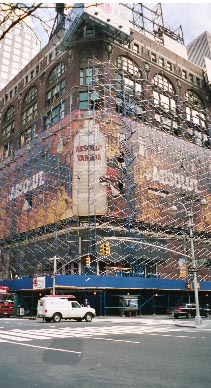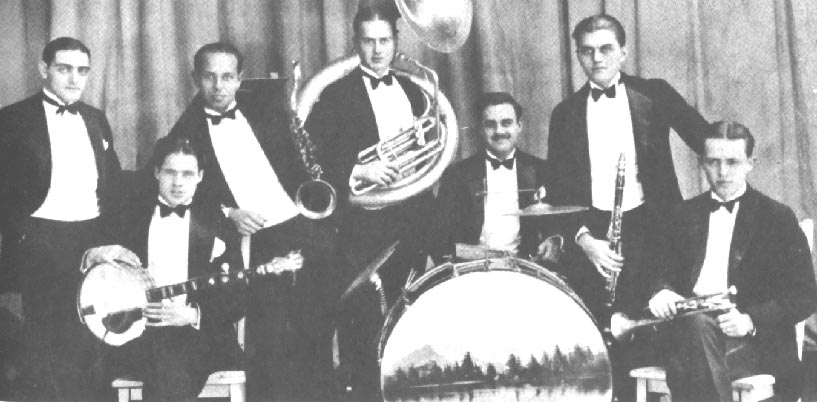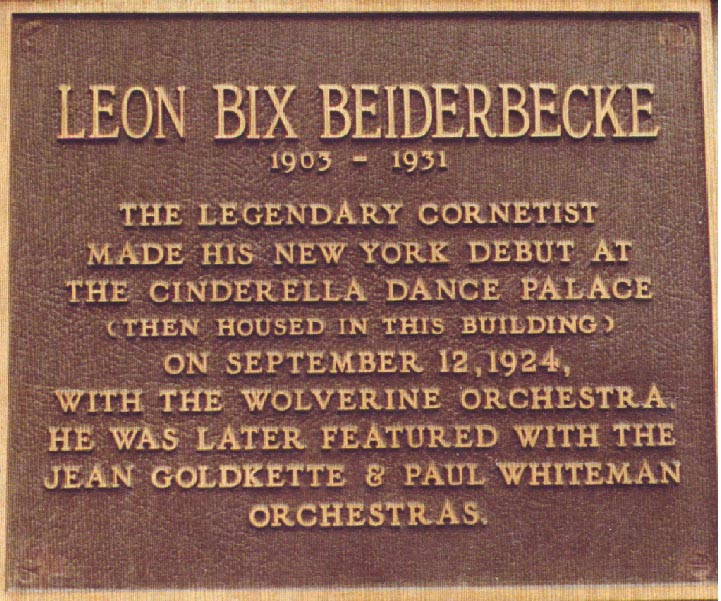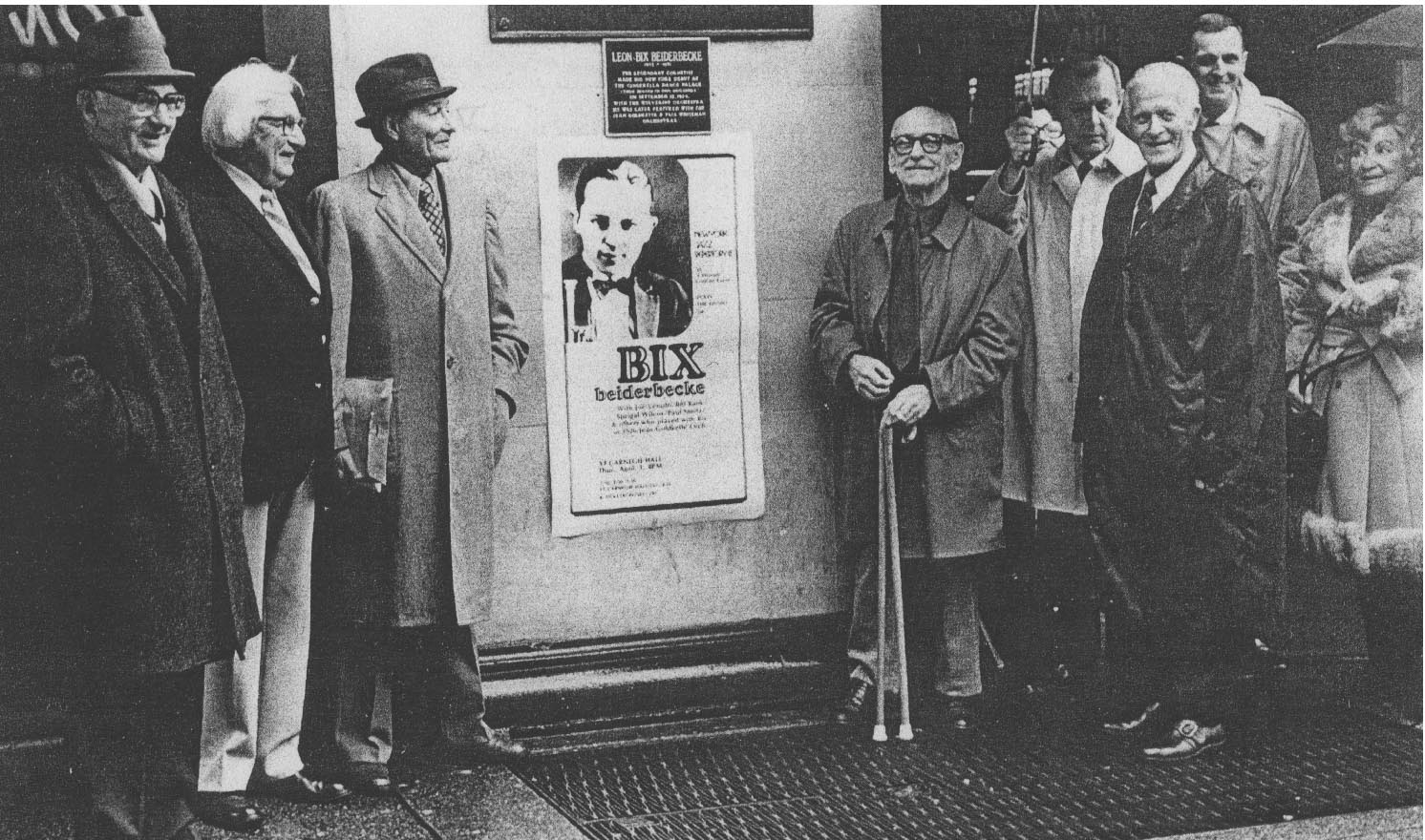
Bix at 1600 Broadway
By
Albert Haim
The 10-story building at 1600 Broadway –in the heart of Times Square-
was built in 1902. When it opened, it housed, in the first floor, a
showroom
for the horse-driven, luxury carriages of the Studebaker Brothers. In
the
1910s, the Mutual Film Company had offices and storage space in the
building.
Charlie Chaplin was under contract with the Company from 1916 to 1918.
In the
1920s and 1930s it housed the Max Fleischer studios: the first Betty
Boop
animated cartoon was created there in 1930 and the popular Popeye was
added in
1933 to the cast of Fleischer’s cartoon characters. In 1939, the ground
floor
was remodelled to house the “Ripley Believe It or Not!
Odditorium”
("Curioddities From 200 Countries").
It was announced early in November 2004 that the building will be
demolished and replaced by a 25-story, 136-unit apartment tower.
The
Wolverine Orchestra at the Cinderella Ballroom.
Bix joined the band at the Stockton
Club, Hamilton, Ohio, late in October 1923. The band did not have much
of a
repertoire. One of the numbers they played quite often was Jelly Roll
Morton’s
“Wolverine Blues.” Thus, the band took up the name “Wolverine
Orchestra.” Late
in 1923, the band consisted of Bix on cornet, Jimmy Hartwell on
clarinet, Bob
Gillette on banjo, Dick Voynow on piano, Ole Vangsnesss on tuba/bass
saxophone,
George Johnson on tenor saxophone, and Bob Conzelman on drums. In
January 1924,
the Wolverines opened at Doyle’s Dancing Academy. Conzelman was
replaced by Vic
Moore, and Vangsness by Wilford “Min’ Leibrook. With the addition of Al
Gandee
on trombone, the Wolverine orchestra made its recording debut at the
Gennett
studios –the cradle of recorded jazz- in Richmond, Indiana on February
18,
1924. One of the numbers waxed on that
day was “Jazz Me Blues” which features the first extended (20 bars)
solo by
20-year old Bix. It is interesting to point out that the solo was
played, note
for note, four months later, by Red Nichols in the George Olsen
recording of
“You’ll Never Get To Heaven with Those Eyes.”
The Wolverines spent the winter,
spring and summer of 1924 in various cities in the Midwest. Early in
September,
they left the Midwest and arrived in New York City for an engagement at
the
Cinderella Ballroom in the building at 1600 Broadway. The Wolverines
opened on
September 12, 1924. This must be viewed as a major achievement: a band
of
youngsters from the Midwest appearing
in one of the top dance halls on Broadway.
Adrian
Rollini’s Orchestra at the Club New Yorker.
Bix was with
the Jean Goldkette
Orchestra (for the second time) from May 1926 to September 1927.
Although the
band was very well regarded, financial considerations resulted in its
dissolution. The last engagement of the band was on September 18, 1927
at
Roseland –the site, one year earlier, of the battle of the century
between the
Jean Goldkette and Fletcher Henderson orchestras. Several of the
Goldkette
musicians -joined the great bass saxophonist Adrian Rollini, who had
secured an
engagement at the Club New Yorker at 1600 Broadway beginning on
September 22,
1927. The musicians in the band were Sylvester Ahola on trumpet, Bix on
cornet,
Bill Rank on trombone, Frank Trumbauer, Don Murray and Bobby Davis on
reeds,
Frank Signorelli on piano, Adrian Rollini on bass saxophone, Eddie Lang
on
guitar, Joe Venuti on violin and Chauncey Morehouse on drums. Although
this was
a formidable group of jazz musicians, they did not attract enough of a
clientele to the Club to make the engagement economically feasible.
Prices were
high (a deluxe dinner was $2.50 with a la carte prices even higher)
and,
according to trumpeter Sylvester Ahola, the clientele was limited
because
liquor was not served. The Club New Yorker closed its doors on October
22,
1927, exactly one month after it had opened. This date marked the last
appearance of Bix at 1600 Broadway.
The Plaque
at 1600 Broadway.
The
plaque is no longer on the building at 1600 Broadway. Trying to recover
it at
this point has become a moot point. The building is scheduled for
demolition. A
landmark for New York City and a shrine for jazzophiles will be gone
soon.
History will receive another blow.
Captions for Images.
1.
1600
Broadway in
the early 1900s.

2.
1600
Broadway in
the early 1930s.

3.
Ripley’s
Believe
It Or Not at 1600 Broadway. 1939.

4.
1600
Broadway in
November 2004.

5.
The
Wolverine
Orchestra at the Cinderella Ballroom. September 1924. Left to right:
Dick
Voynow, Bob Gillette, George Johnson, Min Leibrook, Vic Moore, Jimmy
Hartwell,
Bix Beiderbecke.

6.
Adrian
Rollini’s
New Yorkers at the Club New Yorker, September 1927. Left to right,
seated:
Sylvester Ahola, Bill Rank, Bix Beiderbecke, Frank Trumbauer, Don
Murray, Frank
Signorelli; standing: Eddie Lang, Chauncey Morehouse, Adrian Rollini,
Bobby
Davis, Joe Venuti.

7.
Plaque
at 1600
Broadway. Photographed by Jack Bradley in 1975. Given to Joe Giordano
by Paul
Hutcoe.

8.
Unveiling
of the plaque
at 1600 Broadway. From left to right: Bill Challis, Spiegle Willcox,
Paul
Mertz, Chauncey Morehouse, Paul Hutcoe, Bill Rank, Jeff Atherton and
Virginia
Horvath Morehouse. Photographed by Jack Bradley. July 1975.
